44
Fellow contribution
Pearls of wisdom from my surgical mentors Part I
The term ‘pearls of wisdom’ dates back to Biblical times. In the Old Testament Book of Job it says, ‘No mention shall be made of corals or pearls but the price of wisdom is above rubies’. The pearls of wisdom I have gained from my surgical mentors is the basis of this article. These range in variety like the colours of the rainbow and, at the completion of our careers, Churchill’s words ring true: ‘We make a living by what we get, but we make a life by what we give’. Recently in my consulting rooms I repeated Newton’s experience. He originally observed morning light’s reflection off a mirror painting the colours of the rainbow. I saw the same effect in my consulting suite bathroom. Newton’s scientific eminence ranged from gravitational constants to telescopic investigations of the universe, but he always acknowledged his forebears in this scientific journey. There is a French saying, debout sur les épaules de géants – ‘standing on the shoulders of giants’ – and this mentoring article is an acknowledgement of some of my predecessors’ contributions. The late Max Hickey was my original mentor in the basic science of Anatomy at the University of Queensland. His philosophical and academic style stood him in good stead and, thanks to my father, who was on the senate, his academic appointment was approved by the University Senate in the late 1950s, contrary to the wishes of the Professorial Board. Max had us focus on transverse anatomical sections, the bane of our lives. Little did we know in the late 1970s when CT investigations were established our background was atuned to the use
OPUS LXVIII
of this investigative tool in the diagnosis and management of tumours and malignancies.
Original French version of the dermatome pattern defined on a leather doll of the 1930s.
make a diagnosis, just open up and have a look”.
Transverse section of the mid-thigh showing the relationship of muscles and other vital structures.
The late Sam Mellick was the next rung in this ladder. He was a vascular surgeon from Brisbane and achieved eminence in the Royal Australasian College of Surgeons (RACS) hierarchy, holding positions from censor-in-chief to senior vice president. When visiting him at Ascot we would lunch on seafood and champagne while sitting on his veranda, his favourite distraction. His embracing lecture style imparted wisdom based on experience, something we all have tried to emulate. What a mentor he was. His style was in stark contrast to another eminent lecturer on the Oxford set – W H Auden, the composer of the poem for Rodin’s Thinker. He once lectured in that post-prandial phase after lunch when he said it was like lecturing sleepwalkers. Another figure in this mentoring saga is the late Brian Courtis, who topped the 1944 English Primary Fellowship exam, winning the Hallett Prize. He was tutored by Raymond Last of Last’s Anatomy fame. We all used this famous textbook for our Primary FRACS but some of us had to re-read it. Brian’s philosophical advice for me in surgery was simply, “if you cannot
The late Bob Shannon, trained by Michael DeBakey in Texas, introduced me to vascular surgery for repairing large and small vessels while using the DeBakey forceps. Their gentle apposition in pincer activity was non-traumatic (suitable for coronary vessels), whereas the toothed variety of Adson and Gillies forceps could cause adventitial or paratenon damage in any reconstruction. I joined Benny Rank at the Victorian Plastic Surgery Unit (VPSU) in 1970 to commence my transition in Plastic and Reconstructive Surgery. This was the beginning of my journey into surgical refinement in the fields of head and neck, hand and general reconstructive surgery. London was the next phase in my maturation process. I worked at three major teaching hospitals doing head and neck surgery and established hand units at each. I am grateful to the late David Conroy for suggesting I go to London to do the College course and stay at Nuffield for six weeks – I ended up staying three years. Over lunch at the PANCH (Preston and Northcote Community Hospital) in the Doctors dining hall David suggested I do the English Fellowship, including the College course to become acquainted with surgery on the London scene.

























